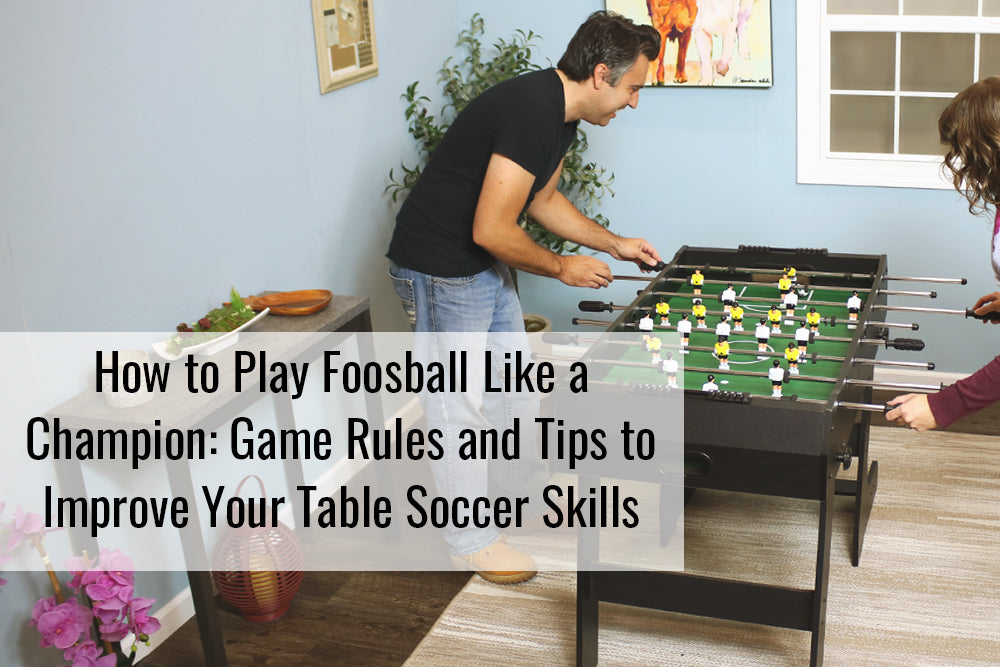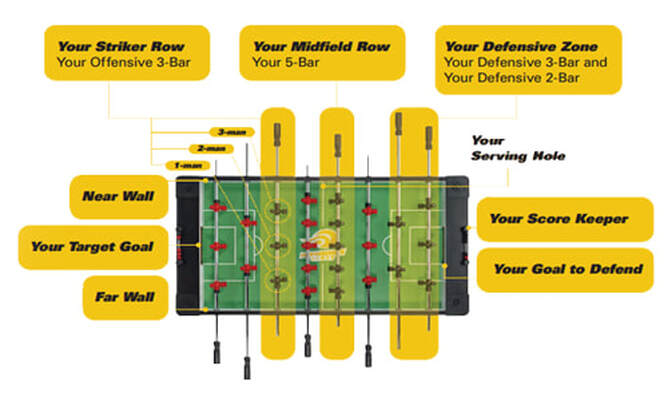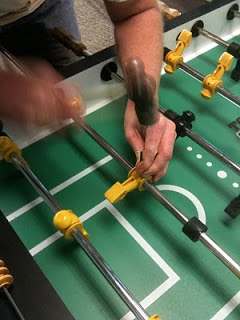Playing foosball is fun and competitive. It’s a great way to enjoy time with friends.
Foosball, a table-top game that mimics soccer, is easy to learn but challenging to master. Whether you’re a beginner or just looking to refresh your skills, understanding the basics is essential. In this guide, we’ll cover everything you need to know about playing foosball.
From setting up the table and understanding the rules to mastering key techniques, we’ve got you covered. Foosball is not just about spinning the rods; it requires strategy, quick reflexes, and coordination. So, let’s dive in and explore how you can improve your game and impress your friends with your foosball skills.

Credit: sunnydazedecor.com
Introduction To Foosball
Foosball, also known as table soccer, is an exciting tabletop game. It simulates soccer with miniature players attached to rods. Players use these rods to kick a ball into the opponent’s goal. This game is fun, fast-paced, and easy to learn. Let’s dive into the basics of foosball.
Brief History
Foosball originated in Europe in the early 20th century. It is believed to have been invented in the 1920s. Harold Searles Thornton from the United Kingdom patented the game in 1921. The game quickly gained popularity across Europe. By the 1950s, it had reached the United States. Today, foosball is enjoyed worldwide by people of all ages.
Basic Rules
Foosball is usually played by two or four players. Each player controls four rods. These rods have miniature players attached. The goal is to score by kicking the ball into the opponent’s goal. The first player to score five goals wins. Players must not spin the rods. Spinning means turning the rods more than 360 degrees. This rule keeps the game fair and challenging. Another key rule is to serve the ball fairly. The ball must be served through the serving hole. It should not be placed directly on the playing field.
Foosball can be played in singles or doubles format. In singles, one player controls all four rods. In doubles, each team member controls two rods. Understanding these basic rules helps players enjoy the game. Foosball is a game of skill, strategy, and quick reflexes.

Credit: www.facebook.com
Choosing The Right Equipment
Playing foosball is a fun and exciting activity for all ages. To enjoy the game to the fullest, having the right equipment is crucial. The quality of the table and balls can significantly affect your gameplay. Let’s delve into how to choose the best foosball tables and balls for an excellent foosball experience.
Types Of Foosball Tables
Foosball tables come in various types, each suitable for different settings and levels of play. Understanding the different types can help you make an informed decision:
- Stand-alone Tables: These are full-sized tables, perfect for serious players and tournaments.
- Tabletop Models: Compact and portable, ideal for children and casual play.
- Convertible Tables: These can be used for multiple games, offering versatility.
- Coin-operated Tables: Common in arcades and bars, designed for commercial use.
Consider the space available and who will be playing. For home use, stand-alone or tabletop models are usually the best choices. If you prefer versatility, a convertible table might be right for you.
Choosing The Right Balls
The ball’s quality can influence your control and the game’s speed. Here are some factors to consider:
- Material: Foosball balls are usually made of cork, plastic, or textured materials. Cork balls offer better control, while plastic balls are more durable.
- Size: Standard foosball balls are 35-38 mm in diameter. Ensure the ball fits well with the table’s players and goals.
- Weight: Heavier balls provide better control and stability. Lighter balls move faster but can be harder to control.
- Surface Texture: Textured balls offer better grip and control. Smooth balls are faster but can be slippery.
Experiment with different types of balls to find which suits your playing style. Having a variety of balls can also keep the game interesting.
Mastering Basic Techniques
Learning to play foosball involves understanding the basic techniques. These include the right grip, stance, and ball control. Let’s explore these techniques to help you improve your game.
Grip And Stance
Grip and stance are essential for effective play. Follow these tips to perfect them:
- Hold the handle with a firm, but relaxed grip.
- Avoid squeezing the handle too tight; it reduces movement.
- Stand with feet shoulder-width apart for stability.
- Bend your knees slightly and keep your body balanced.
Practicing the correct grip and stance will improve your control and precision.
Ball Control
Ball control is key to winning in foosball. Here are some strategies:
- Use the wrist flick technique to pass the ball.
- Trap the ball with your men to stop it.
- Practice passing the ball between your rows.
- Focus on controlling the ball before taking a shot.
Good ball control allows you to set up shots and score more goals.
Advanced Playing Strategies
Mastering foosball requires more than just basic skills. Advanced playing strategies can significantly enhance your game. These tactics involve both offensive and defensive maneuvers. Let’s dive deeper into these strategies.
Offensive Tactics
Offensive tactics are crucial for scoring goals. Here are some effective strategies:
- Ball Control: Keep the ball close to your players. Use soft touches to maintain control.
- Passing: Pass the ball between your players. This confuses your opponent and opens up scoring opportunities.
- Shooting Techniques: Use a variety of shots. The pull shot, push shot, and snake shot are all effective.
- Quick Shots: Take advantage of open shots. Quick, unexpected shots can catch your opponent off guard.
Defensive Tactics
Defensive tactics are equally important. They prevent your opponent from scoring. Here are some key strategies:
- Positioning: Keep your players in the correct positions. This blocks your opponent’s shots.
- Anticipation: Predict your opponent’s moves. This allows you to react quickly and block shots.
- Coordination: Move your defenders in sync. This creates a strong defensive wall.
- Clearing the Ball: Clear the ball from your defensive zone. This prevents your opponent from taking easy shots.
Perfecting Your Shots
Foosball is all about precision and control. To dominate, you need to perfect your shots. Two crucial shots are the Pull Shot and the Push Shot. Each shot requires different techniques, but mastering them will elevate your game.
Pull Shot
The Pull Shot is a powerful move. Start by positioning the ball near your offensive rod. Use your hand to pull the rod towards you while simultaneously flicking your wrist. This creates a quick, powerful shot aimed at the goal.
To improve accuracy:
- Keep your eyes on the ball.
- Practice pulling the rod smoothly.
- Work on your wrist flick for speed.
Consistency is key. Practice regularly to enhance your muscle memory.
Push Shot
The Push Shot is another essential technique. Place the ball near your offensive rod again. This time, push the rod away from you while flicking your wrist. This move sends the ball flying towards the goal.
For better performance:
- Focus on a smooth rod movement.
- Practice the wrist flick for power.
- Maintain a firm grip on the handle.
Like the Pull Shot, practice makes perfect. Regular drills will improve your precision and speed.
Developing Quick Reflexes
Quick reflexes are essential in foosball. They allow you to react swiftly to fast-moving balls and opponents’ moves. Developing these reflexes takes practice and dedication. By focusing on specific drills and routines, you can enhance your reaction time and overall performance in the game.
Reaction Drills
Reaction drills improve your ability to respond quickly. Here are a few effective drills:
- Ball Toss: Have a partner toss the ball at different speeds and angles. Try to catch it as quickly as possible.
- Wall Bounces: Stand close to a wall and bounce the ball off it. Catch it on the rebound to improve hand-eye coordination.
- Partner Pass: Pass the ball back and forth with a partner. Increase the speed gradually to challenge your reflexes.
Practice Routines
Consistent practice helps embed quick reflexes into your muscle memory. Consider the following routines:
- Speed Drills: Focus on moving your players rapidly. Try quick, sharp movements to get used to fast-paced gameplay.
- Game Simulations: Simulate real game scenarios. Play against opponents who are faster to push your limits.
- One-Minute Challenges: Set a timer for one minute. Aim to make as many successful passes or goals as possible within that time.
By incorporating these drills and routines into your practice sessions, you can significantly improve your quick reflexes. This will give you an edge over your opponents and enhance your overall foosball skills.
Reading Your Opponent
Reading your opponent is crucial in foosball. By understanding their habits, you can predict their moves and gain an advantage. This section covers how to recognize patterns and exploit weaknesses.
Recognizing Patterns
To get ahead, watch how your opponent plays. Look for repeated moves. Do they always pass to the right? Do they shoot from the same position? Take note of these patterns.
Consider keeping a simple table to track their moves:
| Move | Frequency |
|---|---|
| Right Pass | 5 times |
| Left Shoot | 3 times |
Patterns can give you clues. If they always pass right, block that path. If they shoot from the left, position your defenders there. Small adjustments can make a big difference.
Exploiting Weaknesses
Once you spot patterns, look for weaknesses. Does your opponent struggle with fast shots? Are they slow to react to certain plays? Identify these gaps in their defense.
Here are some common weaknesses to watch for:
- Slow Reactions: Speed up your game.
- Poor Defense: Aim for open spots.
- Predictable Plays: Anticipate their moves.
If they react slowly, use quick passes and shots. If their defense is weak, aim for those gaps. Predictable plays can be countered easily. Stay alert and adapt your strategy accordingly.
Maintaining Physical And Mental Fitness
Playing foosball is more than just a game. It requires both physical and mental fitness. Building strength and sharpening your mental focus can improve your performance. Let’s explore some effective ways to maintain your physical and mental fitness for foosball.
Strength Training
Strong muscles can enhance your foosball skills. Here are some exercises to include in your routine:
- Wrist Curls: Strengthen your wrists to improve your grip on the handles.
- Forearm Exercises: Build endurance in your forearms for better control.
- Core Workouts: A strong core helps maintain balance during intense games.
- Leg Strength: Squats and lunges can improve your stance and stability.
Regular strength training can make a big difference. Even simple exercises can help.
Mental Focus Exercises
Mental focus is key in foosball. Here are some exercises to boost your concentration:
- Deep Breathing: Practice deep breathing to calm your mind.
- Visualization: Visualize your game strategy before you play.
- Mindfulness Meditation: Stay present and focused during the game.
- Memory Games: Improve your memory with simple games like Sudoku.
Consistent mental exercises can enhance your focus. They help you stay sharp and alert during the game.
Combining physical and mental exercises can lead to better performance. Stay fit and focused to enjoy every foosball game.
Joining Tournaments
Joining a foosball tournament can be an exciting way to test your skills and meet fellow enthusiasts. The competitive spirit and thrill of tournaments offer a unique experience. Here’s how you can start participating in foosball competitions.
Finding Competitions
To find foosball tournaments, check local community centers and sports clubs. Many host regular events. You can also search online for upcoming tournaments. Websites and social media pages often list events in your area.
Consider joining foosball forums and groups. Members often share information about local and national competitions. Connecting with other players can help you stay updated on the latest tournaments.
| Source | Details |
|---|---|
| Local Clubs | Check event boards and newsletters |
| Online Search | Use keywords like “foosball tournaments near me” |
| Foosball Forums | Join discussions and groups |
Preparing For Matches
Preparation is key to success in foosball tournaments. Practice regularly to improve your skills. Focus on ball control, passing, and shooting techniques.
Study your opponents if possible. Watch their previous matches to understand their strategies. This can give you an advantage during the game.
Ensure you have the right equipment. A good foosball table and sturdy rods can make a difference. Keep your gear in top condition.
- Practice daily to enhance your skills.
- Watch videos of your opponents.
- Maintain your equipment.
Finally, stay relaxed and confident. Tournaments can be intense, but a calm mind helps. Focus on your game and enjoy the experience.

Credit: www.youtube.com
Frequently Asked Questions
What Is Foosball?
Foosball is a table-top game resembling soccer. Players use rods to control miniature figures. The objective is to score goals.
How Do You Start A Foosball Game?
A foosball game starts by placing the ball at the center. Each player or team controls their rods. The game begins when the ball is served.
How Many Players Can Play Foosball?
Foosball can be played by two to four players. In a two-player game, each player controls all rods. In a four-player game, each player controls two rods.
What Are The Basic Foosball Rules?
Basic rules include no spinning the rods, serving the ball fairly, and scoring by hitting the ball into the opponent’s goal.
Conclusion
Foosball is a fun and engaging game. Practicing regularly improves your skills. Remember, teamwork and strategy are key. Keep your movements precise and quick. Enjoy the game, and don’t forget to have fun. Playing with friends can make it more enjoyable.
Now, grab those handles and start playing. You’ll improve with each game. Happy playing!


